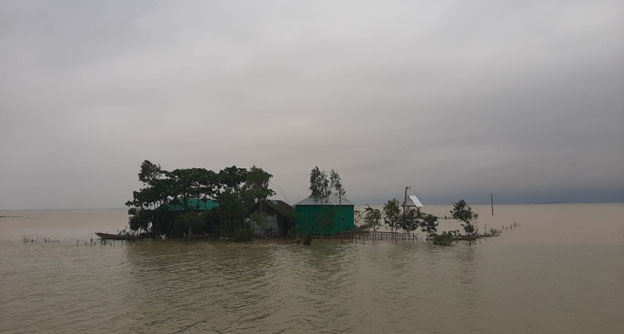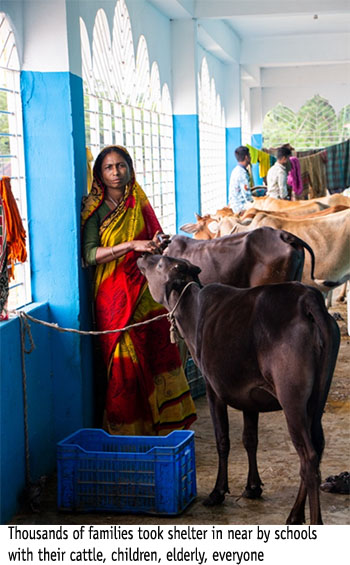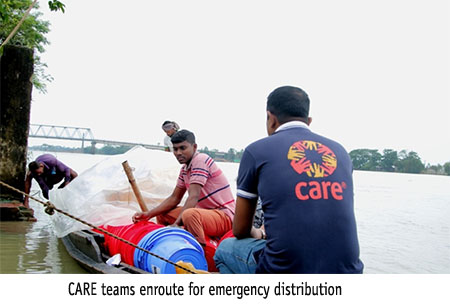
Muhammad Abul Hossain (Shobuj)
When we started for Sunamganj, we did not know how to reach there. Roads were inundated in many places, and boats were not an option against the flow of the flood water. But we were determined to reach there to assure our program participants that are not alone. We were exhausted but thrilled to be able to hear of their distress and their needs. This effort will go a long in ensuring appropriate support to them.
A very small team of two was deployed from country office on June 19, 2022 to help rescue the project staff who were stuck in CARE offices. Incessant rain in the days before and heavy downpour from upstream was escalating the already flash flood affected districts in Bangladesh’s northeastern Sylhet and Sunamganj districts.

By the time we arrived, flood waters had just started receding and native people were beginning to return to their houses to guard and protect their belongings. However, it was nowhere near livable conditions. The rural houses which are mostly build with clay had become wet and muddy, water drinking points had become inundated and most of the latrines were under water or washed away. Thousands of households have lost their farm animals such as cattle, duck, chicken etc. to the flood streams
More than 400,000 people were temporarily displaced in flood shelters. People, farm animals, all were crammed up in the small school rooms. The situation is especially vulnerable for women and girls who had to wait for the sun to go down to be able complete their bathroom needs, that too, outside the shelter centers. There was a serious crisis of dry fuelwood and dry places for cooking.
Humanitarian Response Plan (HRP) of Humanitarian Coordination Task team (HCTT) estimated that approximately 58.4 million USD will be required to address the damages caused by this flood. While for short-term response, food and immediate shelter support is urgently needed. In addition, in order to cope with the overall economic loss, the flood affected families need subsistence allowance, cattle feed and fish fingerling to be able to turn around this massive blow to livelihood.
 With the support from CARE USA and USAID CARE Bangladesh started responding to the crisis with the live savings humanitarian assistance including foods, multi-purpose cash grant, water-sanitation-hygiene promotion and protection services to targeting 15,000 individuals in Sylhet and Sunamganj district. Considering the level of impact, destruction and damage caused by floods CARE, estimating a need for short and long term response, recovery and reconstruction effort in the area of food security & livelihood, WASH, maintenance and restored community infrastructure and houses and integrated protection program addressing risk of gender-based violence (GBV) and sexual reproductive health for women and adolescent girls. CARE estimates USD 6 million will be required to implement the proposed program during July to December 2022.
With the support from CARE USA and USAID CARE Bangladesh started responding to the crisis with the live savings humanitarian assistance including foods, multi-purpose cash grant, water-sanitation-hygiene promotion and protection services to targeting 15,000 individuals in Sylhet and Sunamganj district. Considering the level of impact, destruction and damage caused by floods CARE, estimating a need for short and long term response, recovery and reconstruction effort in the area of food security & livelihood, WASH, maintenance and restored community infrastructure and houses and integrated protection program addressing risk of gender-based violence (GBV) and sexual reproductive health for women and adolescent girls. CARE estimates USD 6 million will be required to implement the proposed program during July to December 2022.
Muhammad Abul Hossain (Shobuj) is the Team Leader for Livelihood & Financial Inclusion, under USAID’s SHOUHARDO III Program implemented by CARE Bangladesh.
Photos: Muhammad Abul Hossain, Apel Pavel, Asafuzzaman Captain